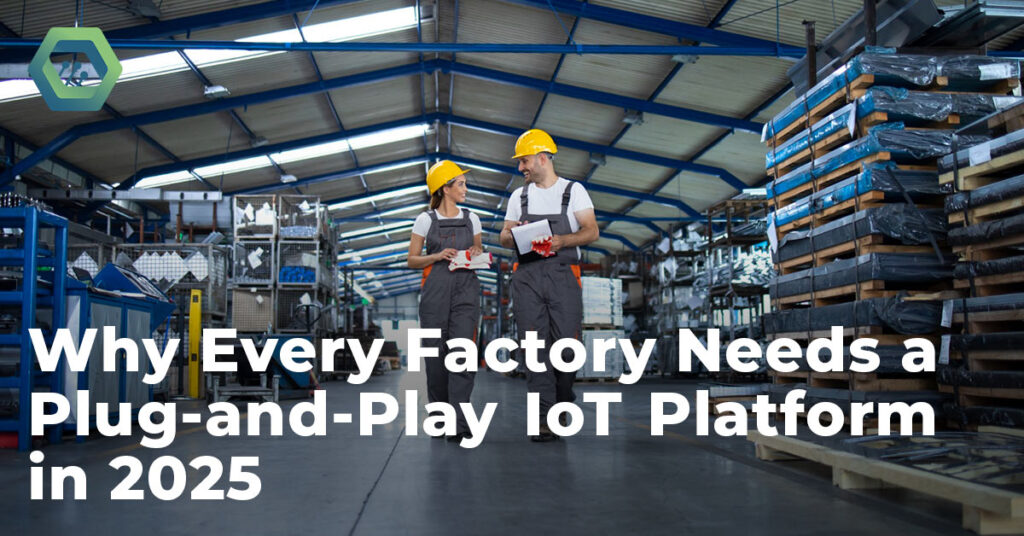The manufacturing industry is changing fast, and factories around the world are looking for better ways to stay efficient and competitive. One major game-changer is the IoT platform — a smart system that connects machines, collects data, and helps managers make better decisions. In 2025, using a plug-and-play IoT platform is no longer a choice; it’s a necessity.
In this blog, we’ll explore why factories should adopt a plug-and-play IoT platform in 2025, how it benefits operations, and what features you should look for.
What Is a Plug-and-Play IoT Platform?
A plug-and-play IoT platform is an easy-to-use system that doesn’t require complex setup or coding. You can connect sensors, devices, and machines quickly, and start collecting data in real time. These platforms are made for fast deployment, easy integration, and scalable growth.
Instead of spending weeks setting up, factories can now go live with a plug-and-play IoT platform in just a few hours or days.
Why 2025 Is the Right Time to Adopt an IoT Platform
Several trends make 2025 the perfect time to switch to a smarter factory:
- 5G and faster internet make it easier to connect devices.
- Cheaper sensors and devices lower the entry cost.
- AI-powered analytics help turn raw data into smart decisions.
- Rising energy costs and labor shortages push factories to become more efficient.
An IoT platform brings all these benefits together in one place.
Top Benefits of Using an IoT Platform in Factories
1. Real-Time Monitoring
Factories can see what’s happening in real time. Whether it’s machine performance, temperature, or energy use, a smart IoT platform shows live data that helps prevent problems before they happen.
2. Predictive Maintenance
Instead of waiting for machines to break down, a factory can use the IoT platform to predict when a part will fail. This saves time, reduces unplanned downtime, and keeps production running smoothly.
3. Energy Efficiency
Energy bills are rising. With an IoT platform, factories can track energy usage by machine or area, find waste, and take action to lower costs.
4. Better Decision-Making
The data collected by the IoT platform is displayed in easy-to-read dashboards. Managers can see trends, identify issues, and make fast, smart decisions.
5. Scalability
Whether you’re running one factory or 50, a plug-and-play IoT platform can scale as your business grows. You can start small and expand without replacing the system.
What Makes a Good IoT Platform for Factories?
When choosing an IoT platform, here are the must-have features:
- Easy Setup – No need for special IT teams or weeks of planning.
- Device Compatibility – Should work with sensors, cameras, and machines from different vendors.
- Secure Data Handling – Must protect your data with encryption and access controls.
- User-Friendly Dashboard – So that even non-technical teams can use the system.
- Custom Alerts and Reports – Get notified about issues or generate daily performance reports.
- Cloud + Edge Computing – Smart processing at the factory level and cloud backup for analytics.
The best IoT platform is one that fits your needs today and grows with your factory tomorrow.
Real Use Case: How One Factory Improved with an IoT Platform
A mid-sized manufacturing unit in India faced constant issues with machine downtime and high energy bills. After installing a plug-and-play IoT platform, they were able to:
- Reduce machine failures by 30%
- Lower energy bills by 18%
- Increase production output by 22%
All this happened within six months of installing the IoT platform.
IoT Platform Trends in 2025 You Should Know
- Edge AI Integration: More platforms are using AI at the edge to make fast decisions without needing internet.
- Voice & Chat Interfaces: Teams can ask questions to the IoT platform and get insights via voice commands or chatbots.
- Sustainability Tools: Platforms now come with tools to help factories lower their carbon footprint.
- Unified Dashboards: One place to monitor production, energy, maintenance, and even safety.
- API Connectivity: Easily integrate with ERP, CRM, or MES systems.
Staying updated with these trends will help you pick the right IoT platform for 2025.
Challenges Without an IoT Platform
If your factory isn’t using an IoT platform, you might face:
- Unexpected machine failures
- High energy usage
- Slow decision-making
- Difficulty tracking production quality
- Limited visibility into operations
These issues can cost you money, time, and reputation. The longer you wait, the more you fall behind your competitors.
Getting Started with Your IoT Platform
Here’s a quick checklist to start:
- List your key machines and assets.
- Decide what you want to monitor – temperature, vibration, energy, etc.
- Pick a plug-and-play IoT platform that supports your goals.
- Start small – monitor one section or machine group.
- Use the platform’s dashboard to find quick wins.
- Scale up once you see benefits.
Final Thoughts
In 2025, factories that don’t use a smart IoT platform will struggle to keep up. Plug-and-play solutions make it easy to start, scale, and succeed. From predictive maintenance and energy saving to smarter decisions and automation — an IoT platform offers it all.
If you’re ready to transform your factory, OmniWOT is here to help. Our powerful IoT platform is built for modern manufacturers — easy to deploy, full of features, and ready for the future. Contact OmniWOT today and bring your factory into the smart era.


